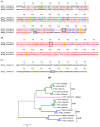Disintegrins from hematophagous sources
- PMID: 22778902
- PMCID: PMC3386632
- DOI: 10.3390/toxins4050296
Disintegrins from hematophagous sources
Abstract
Bloodsucking arthropods are a rich source of salivary molecules (sialogenins) which inhibit platelet aggregation, neutrophil function and angiogenesis. Here we review the literature on salivary disintegrins and their targets. Disintegrins were first discovered in snake venoms, and were instrumental in our understanding of integrin function and also for the development of anti-thrombotic drugs. In hematophagous animals, most disintegrins described so far have been discovered in the salivary gland of ticks and leeches. A limited number have also been found in hookworms and horseflies, and none identified in mosquitoes or sand flies. The vast majority of salivary disintegrins reported display a RGD motif and were described as platelet aggregation inhibitors, and few others as negative modulator of neutrophil or endothelial cell functions. This notably low number of reported disintegrins is certainly an underestimation of the actual complexity of this family of proteins in hematophagous secretions. Therefore an algorithm was created in order to identify the tripeptide motifs RGD, KGD, VGD, MLD, KTS, RTS, WGD, or RED (flanked by cysteines) in sialogenins deposited in GenBank database. The search included sequences from various blood-sucking animals such as ticks (e.g., Ixodes sp., Argas sp., Rhipicephalus sp., Amblyommasp.), tabanids (e.g., Tabanus sp.), bugs (e.g., Triatoma sp., Rhodnius prolixus), mosquitoes (e.g., Anopheles sp., Aedes sp., Culex sp.), sand flies (e.g., Lutzomyia sp., Phlebotomus sp.), leeches (e.g., Macrobdella sp., Placobdella sp.) and worms (e.g., Ancylostoma sp.). This approach allowed the identification of a remarkably high number of novel putative sialogenins with tripeptide motifs typical of disintegrins (>450 sequences) whose biological activity remains to be verified. This database is accessible online as a hyperlinked worksheet and displays biochemical, taxonomic, and gene ontology aspects for each putative disintegrin. It is also freely available for download (right click with the mouse) at links http://exon.niaid.nih.gov/transcriptome/RGD/RGD-Peps-WEB.xlsx (web version) and http://exon.niaid.nih.gov/transcriptome/RGD/RGD-sialogenins.zip (stand alone version).
Keywords: angiogenesis; bloodsucking; disintegrins; hematophagy; platelet aggregation; proteome; salivary; sialogenins; sialome; snake venom; thrombus; transcriptome.
Figures









Similar articles
-
A novel family of RGD-containing disintegrins (Tablysin-15) from the salivary gland of the horsefly Tabanus yao targets αIIbβ3 or αVβ3 and inhibits platelet aggregation and angiogenesis.Thromb Haemost. 2011 Jun;105(6):1032-45. doi: 10.1160/TH11-01-0029. Epub 2011 Apr 7. Thromb Haemost. 2011. PMID: 21475772 Free PMC article.
-
Platelet aggregation inhibitors from hematophagous animals.Toxicon. 2010 Dec 15;56(7):1130-44. doi: 10.1016/j.toxicon.2009.12.003. Epub 2009 Dec 24. Toxicon. 2010. PMID: 20035779 Free PMC article. Review.
-
Non-RGD-containing snake venom disintegrins, functional and structural relations.Toxicon. 2011 Sep 15;58(4):355-62. doi: 10.1016/j.toxicon.2011.07.004. Epub 2011 Jul 21. Toxicon. 2011. PMID: 21801741 Review.
-
Exogenous Integrin αIIbβ3 Inhibitors Revisited: Past, Present and Future Applications.Int J Mol Sci. 2021 Mar 25;22(7):3366. doi: 10.3390/ijms22073366. Int J Mol Sci. 2021. PMID: 33806083 Free PMC article. Review.
-
Recombinant expression of mutants of the Frankenstein disintegrin, RTS-ocellatusin. Evidence for the independent origin of RGD and KTS/RTS disintegrins.Toxicon. 2012 Sep 15;60(4):665-75. doi: 10.1016/j.toxicon.2012.05.010. Epub 2012 Jun 4. Toxicon. 2012. PMID: 22677804
Cited by
-
Amblyomma americanum tick saliva serine protease inhibitor 6 is a cross-class inhibitor of serine proteases and papain-like cysteine proteases that delays plasma clotting and inhibits platelet aggregation.Insect Mol Biol. 2013 Jun;22(3):306-19. doi: 10.1111/imb.12024. Epub 2013 Mar 24. Insect Mol Biol. 2013. PMID: 23521000 Free PMC article.
-
A proteomics informed by transcriptomics insight into the proteome of Ornithodoros erraticus adult tick saliva.Parasit Vectors. 2022 Jan 3;15(1):1. doi: 10.1186/s13071-021-05118-1. Parasit Vectors. 2022. PMID: 34980218 Free PMC article.
-
Inhibition of platelet adhesion, thrombus formation, and fibrin formation by a potent αIIbβ3 integrin inhibitor from ticks.Res Pract Thromb Haemost. 2020 Dec 18;5(1):231-242. doi: 10.1002/rth2.12466. eCollection 2021 Jan. Res Pract Thromb Haemost. 2020. PMID: 33537548 Free PMC article.
-
The "Vampirome": Transcriptome and proteome analysis of the principal and accessory submaxillary glands of the vampire bat Desmodus rotundus, a vector of human rabies.J Proteomics. 2013 Apr 26;82:288-319. doi: 10.1016/j.jprot.2013.01.009. Epub 2013 Feb 11. J Proteomics. 2013. PMID: 23411029 Free PMC article.
-
SARS-CoV-2 Spike Protein Unlikely to Bind to Integrins via the Arg-Gly-Asp (RGD) Motif of the Receptor Binding Domain: Evidence From Structural Analysis and Microscale Accelerated Molecular Dynamics.Front Mol Biosci. 2022 Feb 14;9:834857. doi: 10.3389/fmolb.2022.834857. eCollection 2022. Front Mol Biosci. 2022. PMID: 35237662 Free PMC article.
References
-
- Hood J.D., Cheresh D.A. Role of integrins in cell invasion and migration. Nat. Rev. Cancer. 2002;2:91–100. - PubMed
-
- Silva R., D’Amico G., Hodivala-Dilke K.M., Reynolds L.E. Integrins: The keys to unlocking angiogenesis. Arterioscler. Thromb. Vasc. Biol. 2008;28:1703–1713. - PubMed
-
- McLane M.A., Joerger T., Mahmoud A. Disintegrins in health and disease. Front Biosci. 2008;13:6617–6637. - PubMed
Publication types
MeSH terms
Substances
Grants and funding
LinkOut - more resources
Full Text Sources
Other Literature Sources
Research Materials

